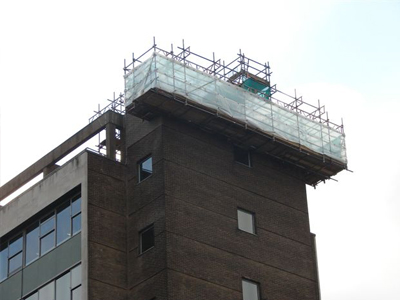Hanging Scaffolds

A hanging scaffold is a scaffold hung from a structure that is static in the vertical plane; it cannot be raised or lowered by any means. Hanging scaffolds can be hung from tubes, wire ropes, ropes or chains etc.
Hanging scaffolds are classified as a special duty scaffold and should be designed and notified as such.
Hanging scaffold foundations are opposite to that of a standing scaffold. Particular attention must be paid to whether the structure the hanging scaffold is to be attached to is able to support the hanging scaffold and its intended loads.
Tube and fitting hanging scaffold
Hanging scaffolds must have additional check clips immediately above the suspension point and immediately below the bottom ledger. Generally a 'T bar' type arrangement should be used approximately 1.0m below the bottom ledger for the scaffolder to stand or sit on while the base lift of the scaffold is erected and dismantled. The T bar should have a check clip under it. Using a double coupler with the gate or flap open is not safe. The double coupler is not designed to take a persons weight and it has been known for the gate or flap to shear off the pin.
Beam clamps used to secure tubes to a beam, rolled steel joist (RSJ), universal beam (UB), etc should, where possible, be used in tandem on either side of the beam and ideally create a box tie around the beam.
It is possible to erect a hanging scaffold lower than the longest standard. In a tube and fitting hanging scaffold joiners must never be used to lengthen a standard. However additional standards may be attached to a minimum of two horizontal ledgers or guardrails within 300mm from the standard. Check clips are used above the ledger and below the ledger supporting the standard.
In system type scaffold the standard must be either joined with high tensile bolts or pins and/or spliced together with tube and fittings. A splice arrangement to connect two standards in tension should have at least two parallel couplers on either side of the standards join connecting each standard to the tube.
Steel Wire Rope (without eyes) used as a hanging scaffold should be fixed to a shackle by a wedge type socket together with a wire rope grip (bull dog clip) fixed to the rope tail. Alternatively, a thimble eye splice can be made using a double base clamp or three fist grip rope clamps. Wire rope grips (bull dog clip) should not be used to secure wire ropes that support persons or substantial materials. Wire rope grips must be correctly applied in order that the stresses within the terminal are evenly distributed. Always fit the grips the same way round, with the bridge on the loaded or long part of the rope and the U-bolt on the short part. On any wire rope a minimum of three grips must be used and spaced at a distance, centre to centre of grips, of six rope diameters.
Steel wire ropes or chains secured around the sharp edges of beams should be protected from damage by beam chaffers. Also ledgers supported from the eyes of slings or from shackles should be provided with a coupler on either side of each support point to prevent the ledger from sliding. Shackle pins must be moused to prevent unwinding.
Call us to discuss your scaffolding requirements - 0800 255 7223
